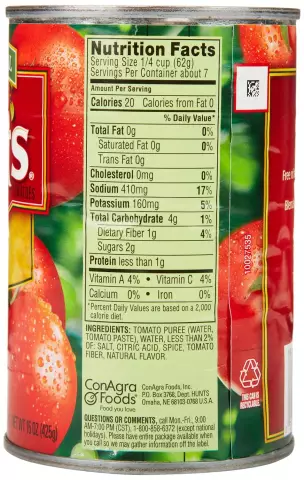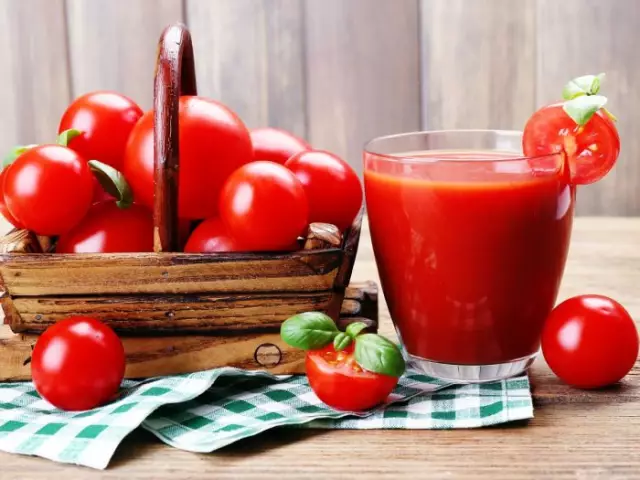- Author Rachel Wainwright [email protected].
- Public 2023-12-15 07:39.
- Last modified 2025-11-02 20:14.
Tomato paste

Tomato paste is a concentrated mass obtained as a result of thermal processing of fresh tomatoes. When making pasta, ripe tomatoes are peeled and seeds removed, wiped and boiled. During cooking, as a result of the evaporation of moisture contained in tomatoes, there is a gradual increase in the concentration of dry matter up to 30-45 percent. The higher the concentration of dry components in the paste, the more tomatoes were used for its preparation and the better it is. Tomatoes retain most of their beneficial properties during heat treatment. Therefore, natural tomato paste made from ripe fresh tomatoes is considered a very healthy product.
The prototype of tomato paste was first made in the 19th century. At that time, Italian chefs tried to make tomato sauce with the addition of olive oil, garlic and pepper. Now tomato paste is produced in two forms - in the form of a salted paste, which is sold in cans or glass, or as an unsalted paste. Unsalted pasta is most commonly sold in barrels.
There are the following varieties of tomato paste: extra, premium and first grade. Extra and premium grade pasta has a rich orange-red color. First grade paste is most often brownish. The most valuable and high quality is the pasta made from tomatoes harvested and processed in one day.
Composition and calorie content of tomato paste
The quality indicator of the paste is the mass fraction of dry matter. Normally, no additional components (flavors, dyes, starch) should be added to tomato paste, since it contains everything you need, including a small amount of salts and sugars.
This product contains starch, mono- and disaccharides, organic acids and dietary fiber. The paste contains a significant amount of vitamin A (300 μg). It also contains vitamins PP, E, C, vitamin B1 and B2. Many of the health benefits of tomato paste are attributed to the significant content of potassium (875 mg), phosphorus (68 mg) and magnesium (50 mg). In addition, the paste contains iron, sodium and calcium.
The calorie content of tomato paste is 100 kcal per hundred grams of product. One hundred grams of the product contains 4.8 g of proteins and 19 g of carbohydrates.
Useful properties of tomato paste
The low calorie content of tomato paste makes it a dietary product. The tomato diet is also recommended for venous diseases and a tendency to thrombus formation. The paste is also recommended for rheumatism and gout.
According to scientists, the highest concentration of the useful natural antioxidant lycopene is observed not in fresh tomatoes, but in boiled or baked vegetables. This valuable natural component in pasta is about ten times more than in fresh tomatoes. It has been proven that the antioxidant lycopene, which protects body cells from the negative effects of the environment and from premature aging, is much better absorbed after heat treatment. Therefore, there are much more useful properties in tomato paste than in fresh tomatoes.

The high potassium content of this product ensures the proper functioning of the cardiovascular system and also helps to lower blood pressure.
American doctors recommend eating tomato paste as often as possible. In their opinion, if you consume at least a small amount of tomato paste or sauces from it every day, the risk of developing cancer is reduced by half. Tomato paste, like the tomatoes themselves, contains the hormone of joy - serotonin. Therefore, its use helps to cope with stress and improves mood. It is advisable to consume at least three dessert spoons of tomato paste daily. It is best to combine fresh tomatoes and sauces based on them. It is important that lycopene is only absorbed in the presence of fat.
Tomato paste improves digestion. When using the product, there is an increased secretion of gastric juice. That is why it is good to use pasta with heavy food, such as pasta.
In spring, this healthy food product can be an excellent substitute for carrots. After all, it contains vitamin A, which is beneficial for vision and slows down the aging process. The phosphorus in the paste helps to strengthen teeth, bones and nails.
The harm of tomato paste
Speaking about the dangers of tomato paste, it should be borne in mind that a natural high-quality product is practically incapable of negatively affecting the human body. The harm from tomato paste can be noticeable if cheap raw materials were used in its manufacture with the addition of water, starch, stabilizers and preservatives.
Care should be taken to use the paste with increased acidity of gastric juice, with gastritis or gastric ulcer, with gallstone disease. Excessive consumption of pasta can lead to increased acidity and discomfort in the stomach.
Found a mistake in the text? Select it and press Ctrl + Enter.






